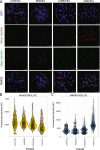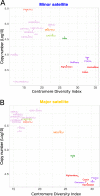Population and subspecies diversity at mouse centromere satellites
- PMID: 33865332
- PMCID: PMC8052823
- DOI: 10.1186/s12864-021-07591-5
Population and subspecies diversity at mouse centromere satellites
Abstract
Background: Mammalian centromeres are satellite-rich chromatin domains that execute conserved roles in kinetochore assembly and chromosome segregation. Centromere satellites evolve rapidly between species, but little is known about population-level diversity across these loci.
Results: We developed a k-mer based method to quantify centromere copy number and sequence variation from whole genome sequencing data. We applied this method to diverse inbred and wild house mouse (Mus musculus) genomes to profile diversity across the core centromere (minor) satellite and the pericentromeric (major) satellite repeat. We show that minor satellite copy number varies more than 10-fold among inbred mouse strains, whereas major satellite copy numbers span a 3-fold range. In contrast to widely held assumptions about the homogeneity of mouse centromere repeats, we uncover marked satellite sequence heterogeneity within single genomes, with diversity levels across the minor satellite exceeding those at the major satellite. Analyses in wild-caught mice implicate subspecies and population origin as significant determinants of variation in satellite copy number and satellite heterogeneity. Intriguingly, we also find that wild-caught mice harbor dramatically reduced minor satellite copy number and elevated satellite sequence heterogeneity compared to inbred strains, suggesting that inbreeding may reshape centromere architecture in pronounced ways.
Conclusion: Taken together, our results highlight the power of k-mer based approaches for probing variation across repetitive regions, provide an initial portrait of centromere variation across Mus musculus, and lay the groundwork for future functional studies on the consequences of natural genetic variation at these essential chromatin domains.
Keywords: Bioinformatics; CENP-A; Centromere; Evolution; Genetic diversity; Inbred mice; Mammalian genomics; Satellite DNA; Wild mice; k-mer.
Conflict of interest statement
None to declare.
Figures






Similar articles
-
Variation in the CENP-A sequence association landscape across diverse inbred mouse strains.Cell Rep. 2023 Oct 31;42(10):113178. doi: 10.1016/j.celrep.2023.113178. Epub 2023 Sep 23. Cell Rep. 2023. PMID: 37742188 Free PMC article.
-
DNA satellite and chromatin organization at mouse centromeres and pericentromeres.Genome Biol. 2024 Feb 20;25(1):52. doi: 10.1186/s13059-024-03184-z. Genome Biol. 2024. PMID: 38378611 Free PMC article.
-
CENP-B binds a novel centromeric sequence in the Asian mouse Mus caroli.Mol Cell Biol. 1995 Aug;15(8):4009-20. doi: 10.1128/MCB.15.8.4009. Mol Cell Biol. 1995. PMID: 7623797 Free PMC article.
-
Sequence, Chromatin and Evolution of Satellite DNA.Int J Mol Sci. 2021 Apr 21;22(9):4309. doi: 10.3390/ijms22094309. Int J Mol Sci. 2021. PMID: 33919233 Free PMC article. Review.
-
Molecular Dynamics and Evolution of Centromeres in the Genus Equus.Int J Mol Sci. 2022 Apr 10;23(8):4183. doi: 10.3390/ijms23084183. Int J Mol Sci. 2022. PMID: 35457002 Free PMC article. Review.
Cited by
-
Evolution of eukaryotic centromeres by drive and suppression of selfish genetic elements.Semin Cell Dev Biol. 2022 Aug;128:51-60. doi: 10.1016/j.semcdb.2022.03.026. Epub 2022 Mar 26. Semin Cell Dev Biol. 2022. PMID: 35346579 Free PMC article. Review.
-
Condensin dysfunction is a reproductive isolating barrier in mice.Nature. 2023 Nov;623(7986):347-355. doi: 10.1038/s41586-023-06700-6. Epub 2023 Nov 1. Nature. 2023. PMID: 37914934 Free PMC article.
-
Population Scale Analysis of Centromeric Satellite DNA Reveals Highly Dynamic Evolutionary Patterns and Genomic Organization in Long-Tailed and Rhesus Macaques.Cells. 2022 Jun 17;11(12):1953. doi: 10.3390/cells11121953. Cells. 2022. PMID: 35741082 Free PMC article.
-
Construction of stable mouse artificial chromosome from native mouse chromosome 10 for generation of transchromosomic mice.Sci Rep. 2021 Oct 8;11(1):20050. doi: 10.1038/s41598-021-99535-y. Sci Rep. 2021. PMID: 34625612 Free PMC article.
-
Meiotic drive in house mice: mechanisms, consequences, and insights for human biology.Chromosome Res. 2022 Sep;30(2-3):165-186. doi: 10.1007/s10577-022-09697-2. Epub 2022 Jul 13. Chromosome Res. 2022. PMID: 35829972 Free PMC article. Review.
References
MeSH terms
Substances
Grants and funding
LinkOut - more resources
Full Text Sources
Other Literature Sources
Molecular Biology Databases
Miscellaneous

